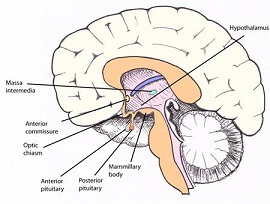
Take Your Learning to New Level
In this course you will learn about the more complex interactions between brain and behaviour and what happens when things go wrong.
Study in the comfort of your own home with support from our excellent and friendly tutors.
- Learn more about the fascinating field of biopsychology.
- Understand more about how our biology and physiology affects how we think.
Pre-requisite: It is best to have studied ‘Biopsychology I’ (or similar) for a better understanding as you work through this course.
Compared to our Biopsychology I course, there is greater emphasis here on the effects of brain damage and drugs on behaviour, and the higher cognitive functions of memory and language are explored in detail.
COURSE STRUCTURE
There are 7 lessons in this course:
- Evolution, Genetics and Experience
- What is biopsychology?
- The organism's genetic endowment, experience and perception.
- Adaptation
- Behavioural genetics
- The nature nurture debate
- The human genome
- Benefits of genetic research
- Critical policy and ethical issues
- Research Methods in Biopsychology
- Behavioural genetics
- Methods of investigating the brain: invasive and non invasive
- Localisation of function
- Neuroanatomical techniques
- Psychophysiological measures
- Other methods
- Lesions
- Brain Damage
- Causes of brain damage
- Frontal lobe damage
- Damage to other areas and effects
- Types of brain damage
- Case study : Phineas Gage
- Case study: diagnosing epilepsy
- Case study -Alzheimer's disease
- Recovery from Brain Damage
- Neuroplasticity
- Stages of recovery: unresponsiveness, early responses, agitated and confused, higher level responses,
- Case study: Parkinson's disease
- Parkinson's disease symptoms, diagnosis, prognosis, stages, etc
- Drug treatments for Parkinson's disease
- Complimentary and supportive therapies for Parkinson's disease
- Coping with Parkinson's disease
- Terminology
- Drug Dependence and the Brain
- Drugs
- Definitions
- Effects of illegal drugs
- Other drugs: steroids, barbiturates, etc
- Physiological and psychological effects of drugs: illicit, stimulants
- Addiction: how drugs work in the brain
- Central nervous system
- Memory
- Models of memory: multistore model, working memory model, levels of processing model
- Levels of processing model
- Amnesia and types of amnesia
- Case study: traumatic amnesia
- Case study: Korsakoff's syndrome (Alcohol amnesic syndrome)
- Language
- The brain and language
- Paul Broca
- Carl Wernicke
- Aphasia and Diphasia
- Apraxia
Each lesson culminates in an assignment which is submitted to the school, marked by the school's tutors and returned to you with any relevant suggestions, comments, and if necessary, extra reading.
WHAT YOU MAY DO IN THIS COURSE
- Viewing behaviour as part genetic and part experiential.
- Discuss how human behaviour is linked to evolution.
- Explain how dominant traits are passed on to offspring by genetics.
- Describe the relationship between gene expression and the genetic code.
- Consider how studies of identical twins shed light on the development of differences among individuals?
- Explain how CT and PET scans are used to obtain images of the brain.
- Determine what invasive research methods have been employed to try and understand the brain and behaviour?
- Consider how drugs are used to understand neurotransmitters and their effect on behaviour?
- Explain how gene knockout and gene replacement techniques are used.
- Outline methods of neuropsychological testing.
- Determine how studying animal behaviour in the laboratory can be useful in understanding human behaviour.
- List and define the most common causes of brain damage.
- Explain the significance of neuron death.
- Explain what happens during neural regeneration and neural degeneration?
- Determine the function of slow and rapid neural reorganisation in the mammalian brain?
- Determine the extent of neurotransplantation of replacement parts in the brain.
- Explain the relationship between physical dependence on drugs and withdrawal syndrome.
- The extent that neural mechanisms seemingly involved in addiction?
- Determine what medial temporal lobe amnesia tell us about implicit and explicit memory?
- Consider cerebral dominance through language lateralisation and left and right-handedness.
- Consider evidence that suggests that the hemispheres of split-brain patients function independently.
- Identify what we now know about lateralisation of function in the left and right hemispheres.
- Evaluate the Wernicke-Geschwind model of cortical localisation of language.
Learn More about the Brain
 Given its overwhelming complexity, the human brain is best understood in terms of its different areas and what they do. Of course, each brain area doesn't act merely by itself, they interact with each other. However, by understanding the different parts we can begin to put together an overall picture of brain biology and function.
Given its overwhelming complexity, the human brain is best understood in terms of its different areas and what they do. Of course, each brain area doesn't act merely by itself, they interact with each other. However, by understanding the different parts we can begin to put together an overall picture of brain biology and function.
The brain and the spinal cord make up the central nervous system (CNS). The brain itself may be divided into the hindbrain, midbrain and forebrain. The hindbrain and midbrain are mainly concerned with our basic life support functions such as breathing, regulation of blood pressure, and so on. The forebrain is responsible for higher brain functions such as our memory and language processes.
The forebrain is where many complex brain processing takes place. It is the centre for memory and learning, as well as motivation and is therefore the area of the brain of most interest to psychologists. In mammals the forebrain is proportionally larger than the hindbrain and midbrain. In fish and reptiles have proportionally larger hindbrains and midbrains. Primates have very large forebrains.
This course helps you to understand the "physical" nature of the brain, and its many parts, primarily in humans; and through this understanding, your perspective and understanding of human psychology will be both broadened and deepened significantly.
Given its overwhelming complexity, the human brain is best understood in terms of its different areas and what they do. Of course, each brain area doesn't act merely by itself, they interact with each other. However, by understanding the different parts we can begin to put together an overall picture of brain biology and function.
The Structure of the Brain
The brain and the spinal cord make up the central nervous system (CNS). The brain itself may be divided into the hindbrain, midbrain and forebrain. The hindbrain and midbrain are mainly concerned with our basic life support functions such as breathing, regulation of blood pressure, and so on. The forebrain is responsible for higher brain functions such as our memory and language processes.
The forebrain is where many complex brain processing takes place. It is the centre for memory and learning, as well as motivation and is therefore the area of the brain of most interest to psychologists. In mammals the forebrain is proportionally larger than the hindbrain and midbrain. In fish and reptiles have proportionally larger hindbrains and midbrains. Primates have very large forebrains.
Why Study This Course?
This course builds on studies undertaken in Biopsychology I and assumes students have some understanding of brain structures and functions.
This course may be studied by itself or as part of a certificate or higher level course. It will be of most interest to those in the following fields:
Psychology
Psychotherapy
Teaching
Research
Biological sciences
Health sciences
Health professions